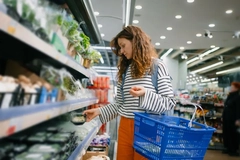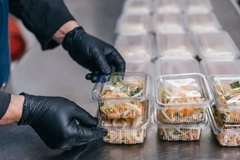UN Global Plastic Treaty: WWF urges binding EPR and global ban list ahead of INC-5.2
The UN Environment Assembly will resume the second part of the fifth session of the Intergovernmental Negotiating Committee on Plastic Pollution (INC-5.2) next week in Geneva, Switzerland. The talks aim to negotiate a legally binding UN Global Plastic Treaty.
While the previous INC sessions established key focus areas and broad agreement on the need for a treaty, their outcome has been criticized as weak and ineffective.
As INC-5.2 (August 5–14) approaches, Packaging Insights sits down with Zaynab Sadan, global plastics lead at WWF, to discuss the potential treaty’s implications for the packaging industry following the stalled dialogue at INC-5.1 in South Korea at the end of last year.
Which packaging formats does WWF view as likely to be on the initial global ban list?
Sadan: The global ban list should eliminate the most harmful and avoidable plastic products. The initial list should target non-essential single-use plastic packaging that is prone to leakage into the environment, disrupts the circular economy, contains intentionally added microplastics or hazardous additives, and packaging with harmful chemicals.
Some examples of packaging products that could be placed on the initial global list are polystyrene (including expanded), PVC, polyvinylidene chloride, and polyethylene terephthalate glycol. These types of packaging do not have a place in a safe, circular economy in practice and at scale, which is what we need to transition to as soon as possible.
An example of a group of chemicals that is commonly used in packaging and that should be placed on the initial global list is bisphenols. Bisphenols are associated with endocrine disruption, reproductive issues, breast cancer, and neurological disorders. They are commonly used to harden plastics in food packaging, reusable water bottles, and baby bottles. Bisphenol A is already banned in some countries due to these potential health risks, and it should be banned at a global level.
How does WWF envision the treaty to impact the plastic packaging industry?
The UN Global Plastic Treaty could include a global ban list to eliminate harmful and avoidable materials.Sadan: We recognize that certain plastic packaging is essential, especially for functionality, safety, and hygiene (for example, food preservation, in pharmaceuticals, and medical devices). The packaging industry would benefit from a regulatory landscape with less complexity than what we are seeing today, which has a high compliance burden and costs.
The Business Coalition for a Global Plastic Treaty, with over 300 members including some of the largest brand owners and users of packaging in the world, is endorsing this call for harmonized global regulations. These businesses urge negotiators to focus on this harmonization of regulations, because it drives consistency across borders, and gives strong signals and directions for industries to innovate packaging design that is safer for human health and the environment, at the same time, levels the playing field for businesses and increases cost-efficiency.
Plastic packaging can be regulated globally in different ways. The first one is to follow harmonized global product design criteria and specific requirements on packaging design that eliminate toxic additives, minimize microplastic shedding, and ensure a non-toxic system that drives safe reuse and recycling. The second one is to mandate design and models for reducing the use of plastic and driving safe reuse and recyclability, such as setting up mandatory EPR schemes.
The treaty will drive transformation and innovation and thus needs to be strengthened over time. One could foresee that packaging deemed essential today could be deemed unessential in the future, and if that is the case, packaging that is also deemed harmful could be moved to the global ban list.
How can the treaty influence EPR schemes globally?
Sadan: A binding obligation for national EPR schemes remains on the table. If agreed upon, parties would need to set up effective schemes for the main plastic waste streams. This usually entails a specific EPR scheme on plastic packaging, as it is a big part of the plastic waste in need of handling.
Guidelines and requirements for these mandatory EPR schemes need to be outlined, and countries will need to report on how this obligation has been fulfilled.
In particular, the waste hierarchy needs to be followed up on with concrete measures. For example, WWF encourages eco-modulation of EPR fees to incentivize circularity. The modulation would give lower fees for safer, reusable, and recyclable packaging and higher fees for packaging with poor reusability and recyclability. In other words, businesses making the correct design choices will get a return on their investment.
What role does WWF see for bio-based plastics in an effective treaty?
Sadan: Compostable, biodegradable, and bio-based plastics are often considered promising substitutes, but they are not a silver bullet for the plastic pollution crisis. A transition away from fossil-based plastics is essential, but it must be accompanied by broader systemic change that prioritizes ecosystem conservation and the protection of communities and livelihoods.
 A binding obligation for national EPR schemes, as part of the UN Global Plastic Treaty, remains possible.Their benefits depend on responsible sourcing and management. Decisions around their use should be guided by metrics and assessed on a case-by-case basis. WWF maintains that all materials, as part of a circular economy, should be intended for recovery and reuse, not disposal into ecosystems or designed to end up in nature. While biodegradable plastics can be useful when supported by appropriate infrastructure, they are not a solution to litter or marine debris.
A binding obligation for national EPR schemes, as part of the UN Global Plastic Treaty, remains possible.Their benefits depend on responsible sourcing and management. Decisions around their use should be guided by metrics and assessed on a case-by-case basis. WWF maintains that all materials, as part of a circular economy, should be intended for recovery and reuse, not disposal into ecosystems or designed to end up in nature. While biodegradable plastics can be useful when supported by appropriate infrastructure, they are not a solution to litter or marine debris.
Consumers frequently misunderstand these materials. Many of them do not degrade in natural environments like oceans and instead require specific conditions, often industrial composting, to break down. In regions lacking such facilities, these plastics often end up in landfills or incinerators. Even bio-based plastics, despite being derived from renewable sources, can persist in the environment if not properly managed.
Moreover, the full range of unintended consequences associated with increased use of these materials — such as deforestation or biodiversity loss — is not yet fully understood. WWF urges industry to focus on developing innovative business models that can drive meaningful and lasting change.
How does WWF envision the finance package for treaty implementation?
Sadan: The treaty must include a predictable, adequate, equitable, and accessible finance package to enable all parties — especially developing countries — to effectively implement treaty obligations.
This entails a financial mechanism that leverages all available sources, mobilizes both public and private resources, and aligns financial flows with the goals of the treaty. For example, the objective of reducing the use of primary plastic polymers by reforming harmful subsidies and tax regimes that incentivize virgin plastic. This will in turn help the market for recyclates to become more competitive.
A formal mechanism to mobilize and distribute resources should be established to address capacity gaps between countries to be governed by the UN COP (Conference of the Parties). The mechanism also needs to secure technical assistance, technology transfer, and capacity building as complementary elements to the financial support.
Is there anything else you would like to highlight?
Sadan: Since the last negotiation round in Busan, Republic of Korea, over 4 million metric tons of plastic have entered the ocean. The cost of inaction is increasing every single day. A weak treaty will only secure the status quo and fail communities most affected by plastic pollution.
Protecting human health and nature requires systemic change and solutions. The world will be watching when decisions are being made in Geneva at INC 5.2. We call on the ambitious majority of states to overcome obstruction using all procedural tools, including voting or forging a majority coalition to get a treaty over the line.












